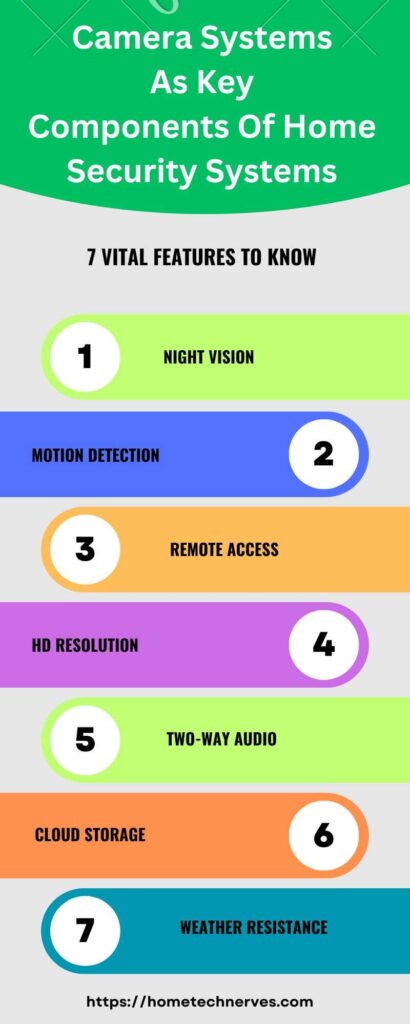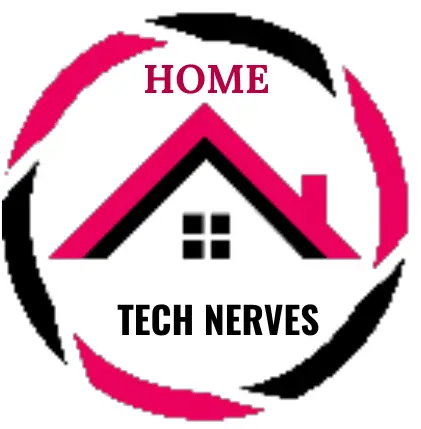Home security systems are essential for protecting your home and family. In today’s world, you need a reliable system that covers all the key components.
These include security cameras, motion sensors, alarms, and smart locks. Each part works together to keep intruders out and provide peace of mind.
With advanced technology, many systems are now easy to install and control through your smartphone.
Plus, they offer real-time alerts. Understanding how these components function can help you choose the best solution.
In this guide, we’ll explore the most important parts of a home security system and how they keep you safe.
Table of Contents
7 Key Components of Home Security Systems
Home security systems consist of key components that work together to protect your property.
These include motion detectors, cameras, control panels, and alarms, each playing a crucial role in monitoring and securing your home against potential threats. Understanding these components ensures better safety and peace of mind.
Here are the crucial components of home security systems:
Camera Systems For Home Security
Camera systems are a vital part of any home security setup. They help monitor your property and deter potential intruders.
With various types and advanced features, choosing the right camera system can greatly enhance the safety of your home.
Features Of Camera Systems
- Night vision: Enables clear video footage even in low light conditions.
- Two-way audio: Allows you to communicate with visitors or potential intruders remotely.
- Motion detection: Alerts you when movement is detected, improving response time.
- Cloud storage: Stores recorded footage online for easy access and review.
- Mobile app integration: Lets you monitor your cameras from anywhere using a smartphone.
Types Of Camera Systems
- Wired cameras: Offer reliable connections but require professional installation.
- Wireless cameras: Easier to install and connect to Wi-Fi, but can be affected by internet outages.
- Indoor cameras: Designed for monitoring the interior of your home with compact designs.
- Outdoor cameras: Built to withstand harsh weather and provide clear footage of your property’s exterior.
- Smart cameras: Integrated with smart home systems, offering advanced features like facial recognition.
Pros And Cons Of Camera Systems
Pros:
- Provides real-time monitoring and security alerts.
- Deters potential intruders from entering the property.
- Can be integrated with other smart home devices for enhanced security.
Cons:
- Wireless systems may suffer from connectivity issues.
- Cloud storage can require additional fees.
- Some systems may be vulnerable to hacking without proper security measures in place.

Motion Sensors For Home Security
Motion sensors are an essential component of home security systems, providing an extra layer of protection.
They detect movement in and around your home and trigger alarms or notifications to alert you.
With various types and features available, motion sensors help enhance your overall security setup.
Features Of Motion Sensors
- Infrared technology: Detects body heat to sense movement and reduce false alarms.
- Pet immunity: Designed to ignore the movement of small pets, avoiding unnecessary alerts.
- Wide coverage range: Capable of monitoring large areas inside or outside your home.
- Integration with alarms: Activates alarms or lights when motion is detected, enhancing security.
- Programmable settings: Allows customization of sensitivity and operational hours for optimal use.
Types Of Motion Sensors
- Passive Infrared (PIR) sensors: Detect body heat and are the most common type for home security.
- Ultrasonic sensors: Use sound waves to detect motion, ideal for sensitive areas.
- Microwave sensors: Emit microwaves to detect movement, offering wide-range detection but with a higher chance of interference.
- Dual technology sensors: Combine two types, like PIR and microwave, for enhanced accuracy and fewer false alarms.
- Area-reflective sensors: Emit infrared rays to detect changes in proximity, suitable for monitoring specific zones.
Pros And Cons Of Motion Sensors
Pros:
- Detects movement instantly, providing quick alerts for suspicious activity.
- Low maintenance, as most sensors are durable and reliable.
- Works in both day and night settings, improving round-the-clock security.
Cons:
- Can trigger false alarms due to pets or environmental changes.
- Some sensors may have blind spots, limiting full coverage.
- Wireless models may be vulnerable to signal interference or power outages.
Doorbell Cameras For Home Security
Doorbell cameras have become a popular addition to home security systems. They offer a convenient way to see and communicate with visitors at your door, even when you’re not home.
With their advanced features and connectivity options, doorbell cameras enhance your home’s safety and convenience.
Features Of Doorbell Cameras
- HD video quality: Provides clear footage, ensuring you can see who is at your door.
- Two-way audio: Enables real-time communication with visitors or delivery personnel.
- Motion detection: Sends alerts when someone approaches your door, improving response time.
- Night vision: Allows for clear video recording in low-light conditions.
- Cloud storage: Offers options to save recorded footage for later viewing and review.
Types Of Doorbell Cameras
- Wired doorbell cameras: Connected directly to your home’s electrical system for a constant power supply.
- Wireless doorbell cameras: Battery-operated and easy to install, providing flexibility in placement.
- Smart doorbell cameras: Integrate with home automation systems, allowing for advanced features like facial recognition.
- Traditional doorbell cameras: Basic models that offer video recording without advanced connectivity.
- Video doorphones: Feature an intercom system for two-way communication along with video capabilities.
Pros And Cons Of Doorbell Cameras
Pros:
- Enhances home security by allowing you to monitor visitors from anywhere.
- Deters potential intruders, knowing they are being recorded.
- Provides a convenient way to communicate with delivery personnel and visitors.
Cons:
- May require a subscription for cloud storage and advanced features.
- Vulnerable to hacking if not properly secured.
- Wireless models may experience connectivity issues or require frequent battery changes.
Smart Alarms For Home Security
Smart alarms are an integral part of modern home security systems. They offer advanced features that provide better protection and peace of mind.
With smart technology, these alarms can alert you in real time and integrate with other security devices for enhanced safety.
Features Of Smart Alarms
- Remote monitoring: Allows you to monitor your home from anywhere using a smartphone app.
- Real-time alerts: Sends instant notifications for suspicious activity or alarm triggers.
- Integration with smart home devices: Connects seamlessly with cameras, motion sensors, and smart locks for a comprehensive security system.
- Customizable settings: Offers options to adjust alarm sensitivity, set schedules, and manage multiple devices.
- Voice control: Compatible with virtual assistants, enabling voice commands to control your alarm system.
Types Of Smart Alarms
- Smart motion detectors: Use advanced technology to detect movement and trigger alarms.
- Smart smoke and carbon monoxide detectors: Alert you to fire or gas leaks with real-time notifications.
- Smart door/window sensors: Monitor entry points and notify you when doors or windows are opened.
- Smart alarm panels: Central hub that manages all your security devices and settings.
- Geofencing alarms: Automatically arm or disarm when you leave or arrive at home.
Pros And Cons Of Smart Alarms
Pros:
- Provides greater control and flexibility for home security.
- Can deter intruders with immediate notifications and alerts.
- Integrates with existing smart home systems for streamlined management.
Cons:
- May require a reliable internet connection for optimal performance.
- Can be costly to install and maintain with additional subscription fees.
- Vulnerable to hacking if not secured properly, potentially compromising your home’s safety.
Thermostats For Home Security
Thermostats play a crucial role in maintaining comfort and energy efficiency in your home.
With advancements in smart technology, modern thermostats offer features that not only regulate temperature but also enhance security.
Understanding the different types and features can help you choose the right thermostat for your needs.
Features Of Thermostats
- Programmable settings: Allows you to set schedules for heating and cooling, optimizing energy use.
- Remote access: Control your thermostat from anywhere using a smartphone app.
- Learning capabilities: Adapts to your routines and preferences, automatically adjusting settings for comfort and efficiency.
- Energy usage reports: Provides insights into energy consumption, helping you make informed decisions.
- Integration with smart home systems: Works with other smart devices for enhanced functionality and convenience.
Types Of Thermostats
- Manual thermostats: Basic models that require manual adjustment for temperature changes.
- Programmable thermostats: Set schedules for heating and cooling, offering more convenience and energy savings.
- Smart thermostats: Connect to Wi-Fi and allow remote control via smartphone, providing advanced features and automation.
- Zoned thermostats: Control temperature in specific areas or zones of your home for tailored comfort.
- Wi-Fi-enabled thermostats: Use internet connectivity for remote access and monitoring, often integrating with other smart devices.
Pros And Cons Of Thermostats
Pros:
- Enhances comfort by maintaining consistent temperatures tailored to your preferences.
- Improves energy efficiency, potentially reducing utility bills.
- Provides remote control and monitoring, adding convenience and flexibility.
Cons:
- Smart models can be expensive and may require a reliable internet connection.
- Some systems may have complex setups or learning curves for optimal use.
- Potential security vulnerabilities if not properly secured, risking unauthorized access to your home system.
Batteries For Home Security
Batteries are a vital component of home security systems, ensuring that devices remain operational even during power outages.
Choosing the right battery type and understanding its features can significantly impact the reliability and performance of your security system.
Here’s a closer look at the different aspects of batteries used in home security.
Features Of Batteries
- Long lifespan: Provides extended usage, reducing the frequency of replacements.
- Quick recharge time: Enables faster recharging, ensuring devices are ready for use promptly.
- Temperature resistance: Functions effectively in a wide range of temperatures, suitable for various environments.
- Low self-discharge rate: Retains charge for longer periods when not in use, ideal for security devices.
- Built-in safety features: Includes protections against overcharging, overheating, and short-circuiting.
Types Of Batteries
- Alkaline batteries: Commonly used for various devices due to their affordability and availability.
- Lithium batteries: Offer longer life and better performance in extreme temperatures, often used in high-tech devices.
- Rechargeable batteries: Can be reused multiple times, providing cost savings and environmental benefits.
- NiMH (Nickel Metal Hydride) batteries: A type of rechargeable battery with higher capacity and less environmental impact than traditional options.
- Li-ion (Lithium-ion) batteries: Widely used in smart devices, offering high energy density and low self-discharge rates.
Pros And Cons Of Batteries
Pros:
- Ensures continuous operation of security devices during power outages.
- Offers flexibility in placement for wireless devices without needing electrical outlets.
- Rechargeable options reduce waste and save money over time.
Cons:
- Batteries may require regular maintenance and replacements, adding to overall costs.
- Performance can degrade over time, leading to inconsistent power delivery.
- Some types may not be suitable for extreme temperatures, affecting reliability in certain conditions.
Base Stations For Home Security
Base stations are the central hubs of modern home security systems, connecting various devices and enabling seamless communication.
They play a crucial role in managing alarms, sensors, and cameras, ensuring that your home remains secure.
Understanding the features, types, and benefits of base stations can help you enhance your security setup.
Features Of Base Stations
- Centralized control: Manages all connected devices, allowing for easy monitoring and control from one location.
- Wireless connectivity: Uses Wi-Fi or cellular networks to communicate with devices, reducing the need for extensive wiring.
- User-friendly interface: Often features touchscreen displays or mobile app integration for easy access and management.
- Real-time alerts: Sends instant notifications to your smartphone or connected devices in case of security breaches.
- Expandable systems: Allows you to add more devices as needed, accommodating changes in your security needs.
Types Of Base Stations
- Wired base stations: Connected directly to the home’s electrical system, providing stable and reliable performance.
- Wireless base stations: Operate on Wi-Fi or cellular networks, offering flexibility in placement and installation.
- Smart base stations: Integrate with other smart home devices, providing advanced features like voice control and automation.
- Hybrid base stations: Combine wired and wireless capabilities, ensuring consistent connectivity and performance.
- Mobile base stations: Portable options that can be used in temporary settings or during emergencies, providing flexibility and adaptability.
Pros And Cons Of Base Stations
Pros:
- Centralizes control of all security devices, simplifying management and monitoring.
- Enhances system reliability by maintaining communication between devices.
- Provides flexibility with wireless options, making installation easier.
Cons:
- May require a stable internet connection for optimal performance, especially for wireless models.
- Some systems can be costly to install and maintain, particularly with advanced features.
- Vulnerable to hacking if not properly secured, potentially compromising your entire security system.
Wrap Up
The key components of home security systems work together to keep you safe. From cameras that monitor your property to motion sensors that alert you of movement, each part plays a vital role.
Smart alarms enhance your security by providing instant notifications, while doorbell cameras allow you to see who is at your door.
Don’t overlook the importance of batteries and base stations in maintaining your system’s reliability.
Investing in these technologies can provide peace of mind. Start securing your home today by exploring the best options for your needs!
Frequently Asked Questions
What are the main components of a home security system?
A home security system typically includes cameras, motion detectors, door/window sensors, alarms, and control panels. Some systems also integrate smart features like mobile app control, video doorbells, and remote monitoring to enhance security and convenience.
How do security cameras contribute to home security?
Security cameras monitor indoor and outdoor areas, recording footage that can deter potential intruders. Modern systems offer features like night vision, motion detection, and real-time mobile alerts, allowing homeowners to keep an eye on their property remotely.
What is the role of motion detectors in a home security system?
Motion detectors sense movement in specific areas and trigger alarms or notifications when suspicious activity is detected. They are commonly used in key entry points or vulnerable areas like garages and backyards to increase security and prevent unauthorized access.
How do smart home security systems work?
Smart home security systems integrate traditional components like alarms and cameras with advanced technology. Homeowners can control their systems remotely via smartphone apps, receive instant alerts, and access live camera feeds, making it easier to monitor and protect their property.


